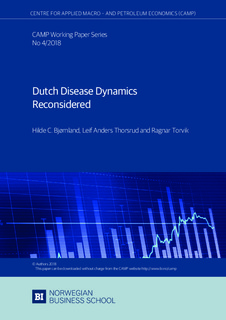| dc.contributor.author | Bjørnland, Hilde C. | |
| dc.contributor.author | Thorsrud, Leif Anders | |
| dc.contributor.author | Torvik, Ragnar | |
| dc.date.accessioned | 2018-02-07T18:31:43Z | |
| dc.date.available | 2018-02-07T18:31:43Z | |
| dc.date.issued | 2018-02 | |
| dc.identifier.issn | 1892-2198 | |
| dc.identifier.uri | http://hdl.handle.net/11250/2483401 | |
| dc.description.abstract | In this paper we develop the first model to incorporate the dynamic productivity consequences of both the spending effect and the resource movement effect of oil abundance. We show that doing so dramatically alters the conclusions drawn from earlier models of learning by doing (LBD) and the Dutch disease. In particular, the resource movement effect suggests that the growth effects of natural resources are likely to be positive, turning previous growth results in the literature relying on the spending effect on their head. We motivate the relevance of our approach by the example of a major oil producer, Norway, where it seems clear that the predictions based on existing theory do not apply. Although the effects of an increase in the price of oil may resemble results found in the earlier Dutch disease literature, the effects of increased oil activity do not. Therefore, models that only focus on windfall gains due to increased spending potential from higher oil prices, would conclude - incorrectly based on our analysis - that the resource sector cannot be an engine of growth. | nb_NO |
| dc.language.iso | eng | nb_NO |
| dc.publisher | BI Norwegian Business School, Centre for Applied Macro- and Petroleum Economics | nb_NO |
| dc.relation.ispartofseries | CAMP Working Paper Series;4 | |
| dc.subject | Dutch disease | nb_NO |
| dc.subject | resource movements | nb_NO |
| dc.subject | earning by doing | nb_NO |
| dc.subject | oil prices | nb_NO |
| dc.subject | time-varying VAR model | nb_NO |
| dc.title | Dutch Disease Dynamics Reconsidered | nb_NO |
| dc.type | Working paper | nb_NO |
| dc.source.pagenumber | 41 | nb_NO |
